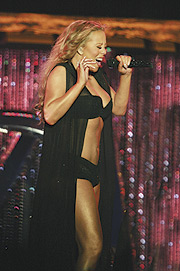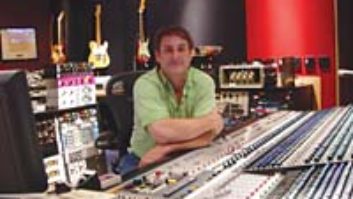
Mariah Carey sings through a bejeweled Shure KSM9.
Photos: Steve Jennings
With 30-plus-years’ experience as a front-of-house engineer, including outings with Sting, James Taylor and Paul Simon, it’s safe to say that Howard Page has seen his share of unusual tour requirements. Perhaps the most surprising specs he’s encountered are on the current Mariah Carey tour, for which the songstress has requested a collection of bejeweled microphones. “The microphone’s jewels have to match the dress she’s wearing, and that changes three, four or five times a night,” reports Page, who now serves as director of engineering at Clair Bros./Showco. “So we have about five or six different mics for her.”
So far, Page and the rest of the crew on the Adventures of Mimi tour have watched the ballad-queen-turned-hip-hop superstar rotate the inventory of microphones at arena shows in Tunisia, Japan, China and all across the United States. When Carey, her four-piece band, three backup singers and a handful of dancers stopped at the Oracle Arena (Oakland, Calif.) in early October, she used silver, black and gold mics.
The all-Clair Bros. tour is carrying an i4 array. Most of the adjustments are made during production rehearsals, leaving Page time to speak about the amount of coverage he is getting from the front and side arrays. “When you attempt to extend the horizontal coverage of a line array system, you have to be incredibly careful,” he explains. “You want to have minimal overlap of the pattern of the main [to avoid] comb filtering, and you want a perfect continuation of the horizontal coverage of the main array. Not only perfect in terms of the dispersion of the main array versus the sides, but also time-aligned. Instead of using artificial methods to make those two systems match, I have designed them such that they are rigged in a perfect arc.”

Front-of-house engineer Howard Page gives Carey’s audience
“an acoustic breath”
in-between pop
and hip hop songs.
Page also spent a fair amount of time perfecting the bottom end, designing a steered sub-bass array. “My role is typically to go out to tours and fix things that are not right, and I’ve been out to many tours where the bottom end is an over-the-top, gut-wrenching, awful noise,” he continues. “Sometimes it’s a gain structure problem, but usually it’s a balance problem.”
On this tour, Page is using Prism II subs. “They give me an absolute depth-defined note,” he says. “They may not be as musical as other subs, but the idea is that for the level that I’m running this show, which is quite loud, I want the tightness. The trade-off, unfortunately, is that I have to sacrifice some depth in the low end to get that definition and hear those notes.”
By steering the subs, he adds, he has virtually eliminated the summing in the middle of the stage. “I’ve evened it out across the floor,” Page says. “When you do that, if you create a true steered array, it not only sounds good on the floor, but it ends up sounding good in the high seats, as well.”
To cover the expensive seats in the front rows, Page is using eight FF2 front-fill cabinets. “I’m a bit of a perfectionist, so I have the middle set on one delay and the outer set on another,” the FOH engineer comments. “The idea with front-fill delays is that you want the image to appear bigger than it really is. That environment in the first two rows is always a bit tricky to get right because if you just put little front-fill speakers down there and turn them on, that is all those people will hear. They don’t get any feeling that they are in a big gig.”
Speakers aside, Page is using a fairly straight-ahead setup at FOH that includes a Yamaha PM5D console and Clair Bros. I/Os driving the system. “In a normal situation with my sound system, the I/Os at front of house are almost straight-through devices,” Page explains. “I’m using them as my D-to-A converters for the output of the Yamaha PM5D. I stay in digital all the way to the I/Os at 96k and then I convert and run analog to my [dbx] DriveRack.”
Page doesn’t rely on much outboard gear — just a touch of onboard limiting and a TC Electronic 6000 multi-effects processor for reverb on Carey’s ballads. “I see guys have compressors on every channel and gates all over the place,” Page says. “Sometimes that’s valid, but what I notice is that it distracts from them mixing the show.”

Monitor engineer Robert Miller chose the Digidesign VENUE digital console for its availability and plug-ins.
MONITOR COMPOUND
At the monitor position, Robert Miller is using a Digidesign VENUE to mix eight pairs of stereo personal monitors, a mix for the engineers below the stage, a mix for monitors that are flown over the stage and placed on the side of the stage for the dancers, and a shaker and a sub. “There are lot of things going on,” he says with a laugh, “but I try to keep it as simple and straightforward as I can.”
Carey uses Ultimate Ears personal monitors, and, yes, the pieces have bling, while the band and backup singers use Future Sonics models. Miller delivers all onstage a straight-ahead mix. “There is nothing too crazy going on,” he says. “Everybody gets a nice blended mix. I’ve worked on some tours where the music is in their left ear and the vocals in their right ear. It’s not like that. Everyone has a stereo mix with good separation.” The flown and side monitor cabinets are Clair Bros. R4s.
Knowing that this tour was going to take them across the globe, Miller picked the VENUE board for its availability and kept the list of plug-ins simple. “I stuck with the standard Digidesign plug-ins so I can get them wherever we go,” he explains. “I didn’t want to be needing something that wasn’t available.” Troodon Technologies’ TrooTrace Audio Analysis Bundle, which he uses as a spectrum analyzer, is one of his more useful plug-ins.
SINGING TO VIDEO
Where it gets challenging, though, is when Carey sings with videotaped performances by such artists as Jay-Z and Jermaine Dupri on the more rap-flavored tracks. “She interfaces with [the video] and Mariah winds vocally in and out between the rap track with this larger-than-life hip hop feel going on behind her,” Page says. “The essential thing is that you have to have the gain structure on your console completely in control at all times. In those circumstances, if you’re not careful of the overall level you’re running or of the interplay between all of the elements of your mix at all times, it will train-wreck in a heartbeat.”
That’s especially true, Page adds, with so many elements to juggle. “There’s the little rap section, now it’s back to Mariah, now a little keyboard riff, now a scratch hook from the DJ,” he describes. “Suddenly, you get a situation that I call ‘everything louder than everything else,’ and you’ve lost any reference point of your mix.”
This tour, featuring Carey’s catalog of songs that bounces between ballads and hip hop tracks, has given Page an opportunity to prove a philosophy that he’s worked with since early in his career. “Excessive low end fatigues an audience, and three-quarters of the way through a show, you notice that they are not as excited and up for the next song as they were in the beginning,” Page says. “It’s essentially because, psycho-acoustically, you are beating them to a pulp with the low end. When I get an opportunity, I give the audience what I call ‘an acoustic breath.’
“There’s an interesting psychological thing that goes on with an audience,” he continues. “They scream their heads off during the show, but when she starts a ballad, they scream for about four words of a song and rather than me turning it up to fight them, I leave it where it is and they all stop screaming. They are essentially here to hear the song. If you give them a dynamic breath, they will come back and they’ll listen.”
David John Farinella is a San Francisco — based writer.


